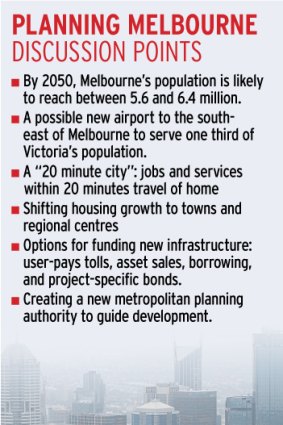This was published 11 years ago
Tale of two cities a happy story for inner suburbs
By Jason Dowling and Richard Willingham
MELBOURNE may be developing as two cities — ''a successful and choice-rich inner core and a fringe with fewer choices'' — a government report has warned.
The discussion paper on planning Melbourne's future, released by the Baillieu government, warns that housing has become less affordable, pushing people further out to where there are fewer services and jobs.

''Not all areas of Melbourne present equal opportunities for economic and social participation,'' the report said.
It warns that ''newer communities on the fringe of the city sometimes have reduced access to jobs, and social and community services''.
In just two decades the number of people fully owning a home in Melbourne has dropped from 40 to 30 per cent and the number of people paying off a mortgage has risen from 30 to 35 per cent.
The report said ''people with less money to spend [who are at greater risk of mortgage stress] can only buy in Melbourne's outer suburban fringe if they want to own a detached house''.
It said while housing might be cheaper further out, transport costs were higher, with much greater car reliance and car-operating costs increasing.
The Age reported yesterday that households on Melbourne's median income of $70,300 a year were being blocked from the city's housing market with few suburbs now affordable.
The new 100-page report, called ''Melbourne, let's talk about the future'', was developed by a committee led by Professor Roz Hansen and has been released by Planning Minister Matthew Guy.
The aim of the report is to generate public debate and feedback on how the city should be developed over the next four decades.
Ideas raised in the report include the development of a new airport to the south-east of Melbourne to serve ''one-third of Victoria's population'', expanding the CBD with 220,000 new residents, including deep into Carlton, and developing a ''20-minute city'' where jobs and services are within 20 minutes of home.
Mr Guy said the 20-minute city might not work all the time.
''It depends where you are, it obviously depends on the day, it depends on the location and what you are aiming to do, it's a conceptual idea about getting Melbourne and the services for people within a 20-minute time frame of their location,'' he said.
He denied that building a rail line to Tullamarine airport would be cheaper than building a new airport in the south-east because, he said, the new airport would be privately financed.
Opposition planning spokesman Brian Tee said the government had to provide more opportunities to people living in Melbourne's newest suburbs.
''Without public transport or jobs, Mr Baillieu's outer suburbs become poverty traps with two-car families wrestling with higher petrol prices and rising costs of living,'' he said.
Jennifer Cunich, from the Property Council, welcomed the planning discussion paper and said there should be no ''sacred cows in this important community debate''.
''The property sector is glad to see that the prospect of a depoliticised metropolitan planning authority has been raised for discussion,'' she said.